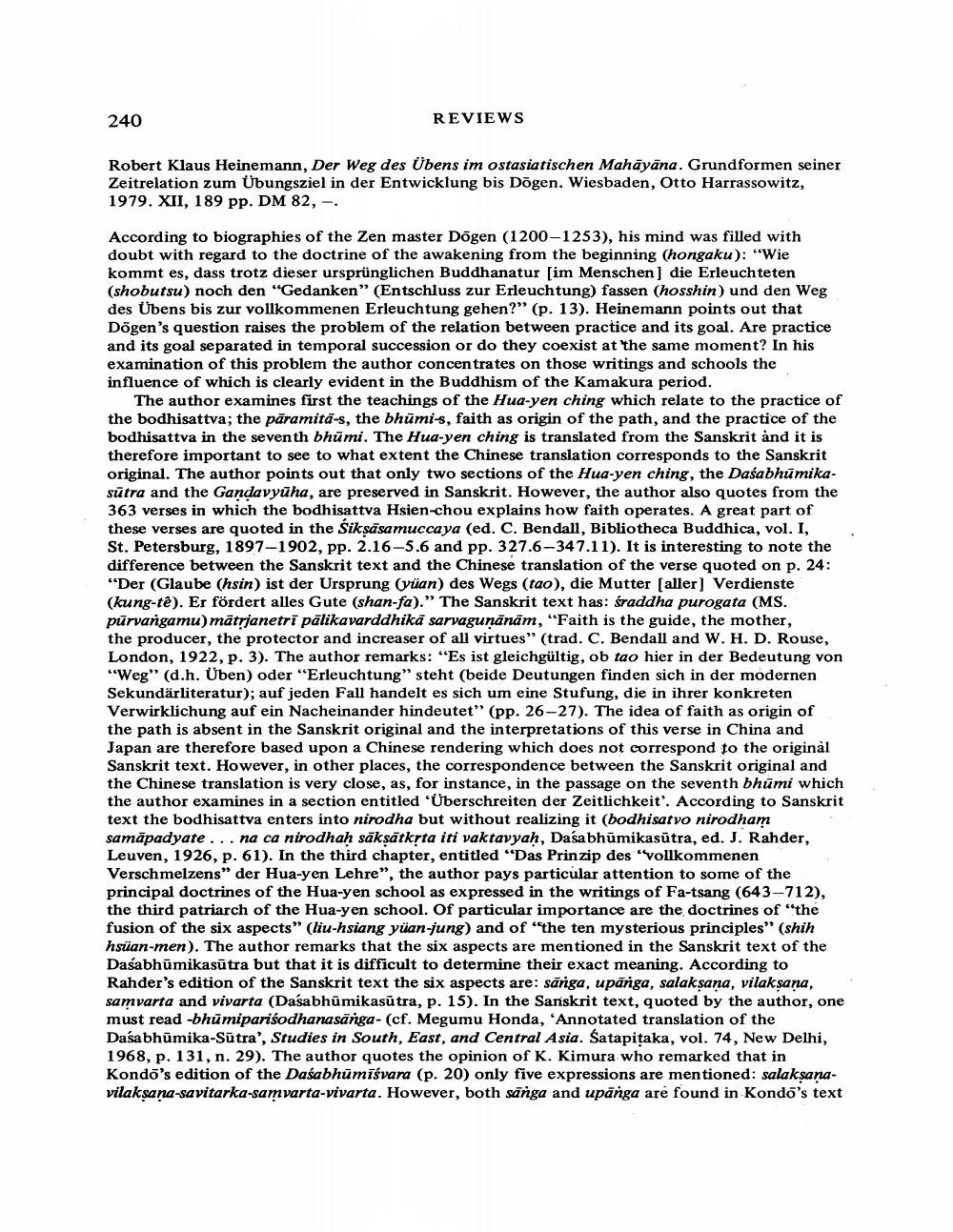________________
240
REVIEWS
Robert Klaus Heinemann, Der Weg des Übens im ostasiatischen Mahāyāna. Grundformen seiner Zeitrelation zum Übungsziel in der Entwicklung bis Dögen. Wiesbaden, Otto Harrassowitz, 1979. XII, 189 pp. DM 82,
According to biographies of the Zen master Dōgen (1200-1253), his mind was filled with doubt with regard to the doctrine of the awakening from the beginning (hongaku): "Wie kommt es, dass trotz dieser ursprünglichen Buddhanatur [im Menschen) die Erleuchteten (shobutsu) noch den "Gedanken" (Entschluss zur Erleuchtung) fassen (hosshin) und den Weg des Übens bis zur vollkommenen Erleuchtung gehen?” (p. 13). Heinemann points out that Dögen's question raises the problem of the relation between practice and its goal. Are practice and its goal separated in temporal succession or do they coexist at the same moment? In his examination of this problem the author concentrates on those writings and schools the influence of which is clearly evident in the Buddhism of the Kamakura period.
The author examines first the teachings of the Hua-yen ching which relate to the practice of the bodhisattva; the pāramita-s, the bhūmis, faith as origin of the path, and the practice of the bodhisattva in the seventh bhūmi. The Hua-yen ching is translated from the Sanskrit and it is therefore important to see to what extent the Chinese translation corresponds to the Sanskrit original. The author points out that only two sections of the Hua-yen ching, the Daśabhūmikasūtra and the Gandavyūha, are preserved in Sanskrit. However, the author also quotes from the 363 verses in which the bodhisattva Hsien-chou explains how faith operates. A great part of these verses are quoted in the Siksāsamuccaya (ed. C. Bendall, Bibliotheca Buddhica, vol. I, St. Petersburg, 1897-1902, pp. 2.16-5.6 and pp. 327.6-347.11). It is interesting to note the difference between the Sanskrit text and the Chinese translation of the verse quoted on p. 24: "Der (Glaube (hsin) ist der Ursprung (yüan) des Wegs (tao), die Mutter (aller] Verdienste (kung-tê). Er fördert alles Gute (shan-fa).” The Sanskrit text has: śraddha purogata (MS. pūrvangamu) mātsjanetrī pālikavarddhikā sarvaguņānām, “Faith is the guide, the mother, the producer, the protector and increaser of all virtues" (trad. C. Bendall and W. H. D. Rouse, London, 1922, p. 3). The author remarks: "Es ist gleichgültig, ob tao hier in der Bedeutung von “Weg" (d.h. Üben) oder "Erleuchtung" steht (beide Deutungen finden sich in der modernen Sekundärliteratur); auf jeden Fall handelt es sich um eine Stufung, die in ihrer konkreten Verwirklichung auf ein Nacheinander hindeutet” (pp. 26-27). The idea of faith as origin of the path is absent in the Sanskrit original and the interpretations of this verse in China and Japan are therefore based upon a Chinese rendering which does not correspond to the original Sanskrit text. However, in other places, the correspondence between the Sanskrit original and the Chinese translation is very close, as, for instance, in the passage on the seventh bhumi which the author examines in a section entitled 'Überschreiten der Zeitlichkeit'. According to Sanskrit text the bodhisattva enters into nirodha but without realizing it (bodhisatvo nirodham samāpadyate ... na ca nirodhah sāksātkrta iti vaktavyah, Dasabhūmikasūtra, ed. J. Rahder, Leuven, 1926, p. 61). In the third chapter, entitled "Das Prinzip des "vollkommenen Verschmelzens" der Hua-yen Lehre", the author pays particular attention to some of the principal doctrines of the Hua-yen school as expressed in the writings of Fa-tsang (643-712), the third patriarch of the Hua-yen school. Of particular importance are the doctrines of "the fusion of the six aspects" (liu-hsiang yuan-jung) and of the ten mysterious principles" (shih hsüan-men). The author remarks that the six aspects are mentioned in the Sanskrit text of the Dasabhūmikasūtra but that it is difficult to determine their exact meaning. According to Rahder's edition of the Sanskrit text the six aspects are: sárga, upanga, salaksana, vilaksana, samvarta and vivarta (Dasabhūmikasūtra, p. 15). In the Sanskrit text, quoted by the author, one must read -bhumiparisodhanasanga- (cf. Megumu Honda, 'Annotated translation of the Daśabhūmika-Sūtra', Studies in South, East, and Central Asia. Satapitaka, vol. 74, New Delhi, 1968, p. 131, n. 29). The author quotes the opinion of K. Kimura who remarked that in Kondo's edition of the Daśabhūmīśvara (p. 20) only five expressions are mentioned: salaksanavilaksana-savitarka-samvarta-vivarta. However, both sanga and upanga are found in Kondo's text




